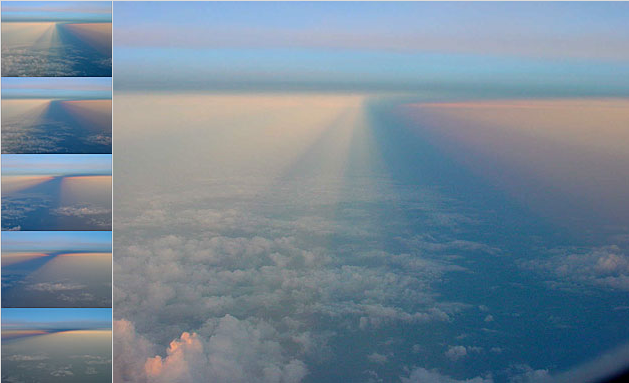Anti-crepuscular rays
Anti-Crepuscular Rays: A Phenomenon of Light and Shadows
Have you ever gazed at the sky and been captivated by the interplay of light and shadows? One fascinating atmospheric optical phenomenon that often goes unnoticed is the occurrence of anti-crepuscular rays. While crepuscular rays are commonly observed during sunrise or sunset, their less-known counterpart, anti-crepuscular rays, provide a mesmerizing spectacle that can leave you in awe.
What are Anti-Crepuscular Rays?
Anti-crepuscular rays, also known as antisolar rays, are beams of sunlight that appear to converge towards the point in the sky opposite to the sun. Unlike crepuscular rays, which are visible when sunlight passes through gaps in clouds or other obstructions, anti-crepuscular rays form due to the scattering of sunlight by dust or water droplets in the atmosphere.
The Illusion of Convergence
When viewing anti-crepuscular rays, one might perceive a striking illusion of convergence. This 3D motion sensation gives the impression of flying through the rays as they appear to meet at a point on the horizon. This captivating experience is a result of the perspective effect caused by our viewing position on Earth.
Atmospheric Conditions and Formation
Anti-crepuscular rays typically form when the sun is low on the horizon, near sunrise or sunset. The conditions necessary for their formation include a clear atmosphere with suspended particles such as dust or water droplets. These particles act as scattering agents, redirecting sunlight and creating the visible beams that converge opposite to the sun.
The Role of Perspective
The perspective effect plays a crucial role in the appearance of anti-crepuscular rays. When we observe these rays from the ground, they appear to converge towards a point on the opposite side of the sky. However, in reality, the rays are parallel to each other and only appear to intersect due to the way our eyes perceive depth and distance.
Similarities to Crepuscular Rays
While anti-crepuscular rays are less well-known than their crepuscular counterparts, they share similarities in their formation and appearance. Both phenomena result from the scattering of sunlight by atmospheric particles. However, while crepuscular rays are visible in the direction of the sun, anti-crepuscular rays appear opposite to the sun.
Capturing the Beauty
Photographers and sky enthusiasts often capture the beauty of anti-crepuscular rays through stunning photographs. These images showcase the convergence of the rays as they stretch across the sky, creating a visually captivating scene. To capture this phenomenon, it is essential to be in the right place at the right time, preferably in an open area with an unobstructed view of the horizon.
Natural Wonders and Cosmic Connections
The occurrence of anti-crepuscular rays serves as a reminder of the intricate interplay between light, shadows, and atmospheric conditions. This natural wonder highlights the beauty and complexity of our planet's atmosphere. Additionally, it provides a cosmic connection, reminding us of our place in the vast universe and the wonders that unfold above us.
Beyond Anti-Crepuscular Rays
While anti-crepuscular rays offer a captivating display of converging light, they are just one example of the many atmospheric optical phenomena that occur around us. From rainbows and halos to iridescent clouds and sun pillars, our atmosphere is a canvas for a variety of mesmerizing displays. Exploring these phenomena can deepen our appreciation for the intricate workings of nature and the ever-changing spectacle above.
A Reminder to Look Up
Next time you find yourself gazing at a breathtaking sunrise or sunset, take a moment to observe the sky beyond the horizon. You might just catch a glimpse of the elusive anti-crepuscular rays, reminding you of the hidden wonders that exist in the vast expanse above us. So, remember to look up, for there is a universe of beauty waiting to be discovered.

Rays & Shadows from the air.
Sequence imaged between Hong Kong and Seoul by Simon Murray, "as one passes these rays, there is a strong 3D motion sensation of flying through them".
Images ©2003 Simon Murray, shown with permission.
Note: this article has been automatically converted from the old site and may not appear as intended. You can find the original article here.
Reference Atmospheric Optics
If you use any of the definitions, information, or data presented on Atmospheric Optics, please copy the link or reference below to properly credit us as the reference source. Thank you!
-
<a href="https://atoptics.co.uk/blog/anti-crepuscular-rays/">Anti-crepuscular rays</a>
-
"Anti-crepuscular rays". Atmospheric Optics. Accessed on November 26, 2024. https://atoptics.co.uk/blog/anti-crepuscular-rays/.
-
"Anti-crepuscular rays". Atmospheric Optics, https://atoptics.co.uk/blog/anti-crepuscular-rays/. Accessed 26 November, 2024
-
Anti-crepuscular rays. Atmospheric Optics. Retrieved from https://atoptics.co.uk/blog/anti-crepuscular-rays/.